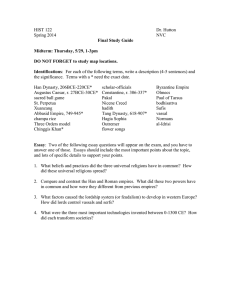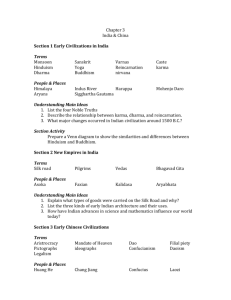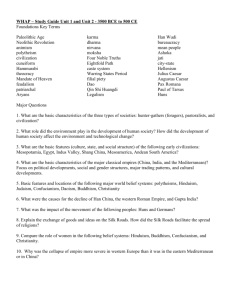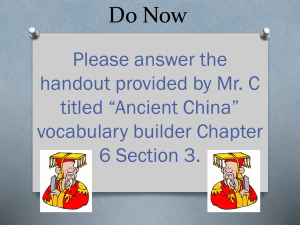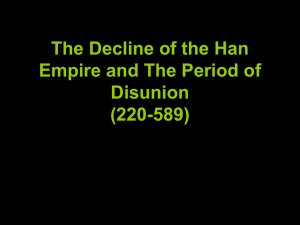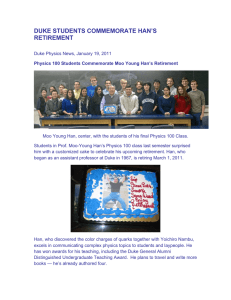Study Guide - LaRoue's online classroom
advertisement
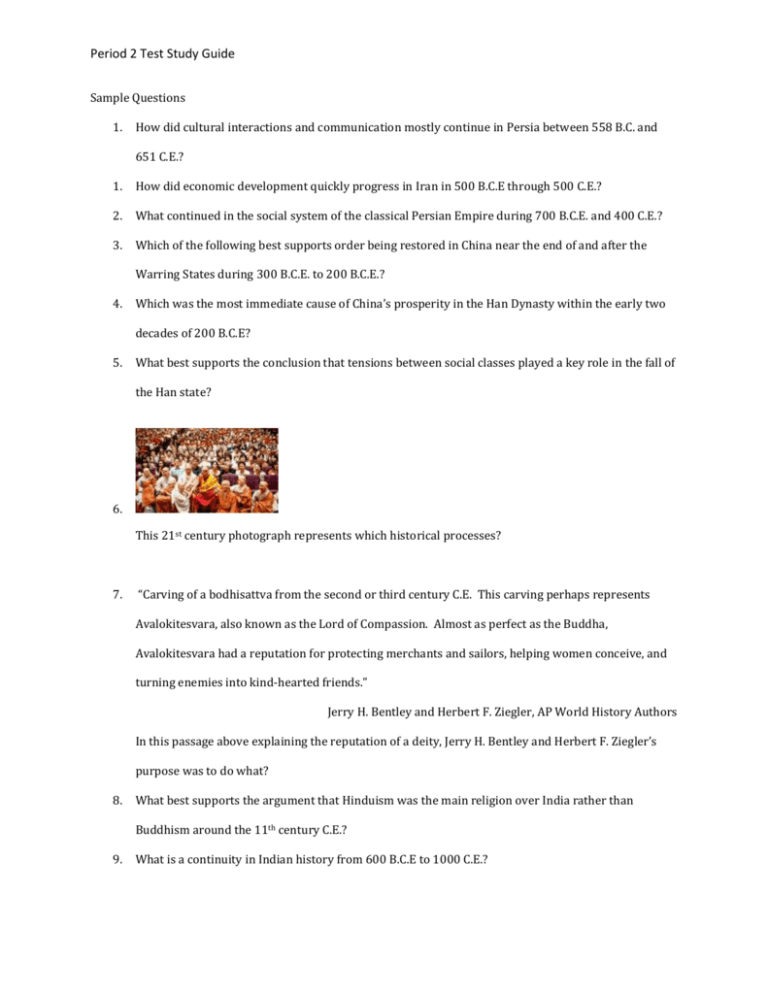
Period 2 Test Study Guide Sample Questions 1. How did cultural interactions and communication mostly continue in Persia between 558 B.C. and 651 C.E.? 1. How did economic development quickly progress in Iran in 500 B.C.E through 500 C.E.? 2. What continued in the social system of the classical Persian Empire during 700 B.C.E. and 400 C.E.? 3. Which of the following best supports order being restored in China near the end of and after the Warring States during 300 B.C.E. to 200 B.C.E.? 4. Which was the most immediate cause of China’s prosperity in the Han Dynasty within the early two decades of 200 B.C.E? 5. What best supports the conclusion that tensions between social classes played a key role in the fall of the Han state? 6. This 21st century photograph represents which historical processes? 7. “Carving of a bodhisattva from the second or third century C.E. This carving perhaps represents Avalokitesvara, also known as the Lord of Compassion. Almost as perfect as the Buddha, Avalokitesvara had a reputation for protecting merchants and sailors, helping women conceive, and turning enemies into kind-hearted friends.” Jerry H. Bentley and Herbert F. Ziegler, AP World History Authors In this passage above explaining the reputation of a deity, Jerry H. Bentley and Herbert F. Ziegler’s purpose was to do what? 8. What best supports the argument that Hinduism was the main religion over India rather than Buddhism around the 11th century C.E.? 9. What is a continuity in Indian history from 600 B.C.E to 1000 C.E.? Period 2 Test Study Guide 10. The map above exemplifies which of the historical processes in 800 B.C.E. to 500 B.C.E? 11. What was an important long-term cause of successful trade within the Mediterranean Basin in 8th century B.C.E? 12. “And you too, judges, must face death with a good courage, and believe this as a truth, that no evil can happen to a good man, either in life, or after death. His fortunes are not neglected by the gods, and what has come today has not come by chance. I am persuaded that it is better for to die now, and to be released from trouble. . . . And so I am hardly angry with my accusers, or with those who have condemned me to die. Yet it was not with this mind that they accused me and condemned me, but rather they meant to do me an injury. Only to extend do I find fault with them.” F. J. Church, Author of The Trial and Death of Socrates What is the purpose of Socrates views on his life during the early 5th century in the passage above? 13. What was the long-term cause of the economic expansion in Greece to decline? 14. 22. If any one is committing a robbery and is caught, then he shall be put to death. 42. If any one take over a field to till it, and obtain no harvest therefrom, it must be proved that he did no work on the field, and he must deliver grain, just as his neighbor raised, to the owner of the field. 119. If any one fail to meet a claim for debt, and he sell the maid servant who has borne him children, for money, the money which the merchant has paid shall be repaid to him by the owner of the slave and she shall be freed. Translated by L. W. King In this account of Hammurabi’s Law Code, who is his audience? 15. What was a major change in the declining years of the Han China Empire? 16. What was an important factor to the economic development of empires within Egypt and West Africa in late 1000 B.C.E.? Period 2 Test Study Guide 17. What was a long-term cause of a developed Religious Kingdom within Ethiopica in 300 C.E.? 18. What is an accurate difference between Hinduism and Buddhism in India during 500 C.E. through 600 C.E.? 19. What contributed significantly to the decline of power in Gupta India, Rome, and China during 200 C.E.? 20. What was a major change in economy of Carthage from 400 B.C.E. to 200 C.E.? 21. What best supports the assertion that a social hierarchal system was always used by the society of the Greeks, Africans, and Chinese in 500 B.C.E. through 500 C.E.? 22. “For example, diverse epidemic diseases of humans evolved in areas with many wild plants and animal species suitable for domestication, partly because the resulting crops and livestock helped feed dense societies in which epidemics could maintain themselves, and partly because the diseases evolved from germs of the domestic animals themselves.” Jared Diamond, Biologist Create a sentence that bests states the argument of the evidence provided? 23. What both significantly contributes to the authority Mrs. LaRoue holds within the AP World History classroom setting in the 21st century and the authority of Alexander III of Macedon in 400 B.C.E.? 24. What contrasts the new economic concepts and technology between the Qin Dynasty and the Han Dynasty? Things to study Period 2 events and people and how the fit into the themes! 1. 2. 3. 4. 5. Interaction between humans and the environment Development and interaction of cultures State-building, expansion, and conflict Creation, expansion, and interaction of economic systems Development and transformation of social structures. The Quizzes we have been doing this whole time!
